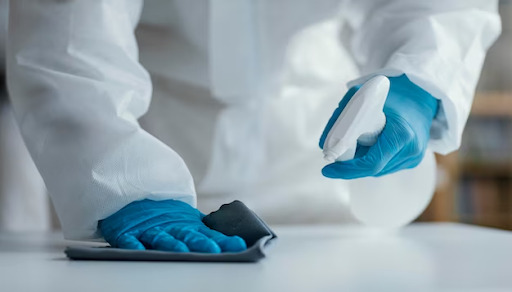Laboratories are unique environments. Their purpose is to conduct experiments and research in a safe, sterile environment, free from contamination and other hazards. To do so regular cleaning and maintenance must be done to ensure the safety of everyone involved. This blog looks at how to keep safe in a lab by maintaining a clean environment.
Reasons for Cleaning your Laboratory:
- Contamination Prevention – A contaminated lab not only puts you and others at risk, but it can also compromise samples and results. When you eliminate the possibility of introducing foreign substances or cultures to your samples, you can ensure the accuracy of your results.
- Organisation – The cleanliness and tidiness of the laboratory can heavily influence the overall operational efficiency of the laboratory. Additionally, organisation can boost personnel morale by providing a happier and more efficient working environment.
- Keeps the laboratory safe – In a laboratory, it is crucial to ensure the health and safety of employees, as they can be full of hazardous materials or risks to workers’ safety.
- Cost Saving: We have already established that untidy workspaces can cause contamination or create issues with productivity. By keeping your lab tidy, you can save time repeating experiments and wasting costly supplies.
- Compliance. By following thorough cleaning and sanitation methods, you will be able to meet any health and safety regulations and laws that apply directly to laboratories. Infractions of these laws can result in severe penalties and fines for your lab, so it is essential to follow the regulations set out by the HSE.
Scheduling Cleaning Time
Unclean laboratories can be dangerous, especially for weighing stations, since leftover chemicals, such as liquids and powders, can harm others. The first step in maintaining a clean and safe lab is scheduling regular cleaning times. It is often inconvenient to schedule cleaning; however, all your effort will be futile if samples are contaminated due to dirty lab conditions. Depending on the type of lab you have, this could mean daily or weekly cleaning according to the level of use and the number of personnel present at any given time. Create a weekly schedule for cleaning areas that require regular maintenance, such as dusting benches, emptying biohazard waste containers, and maintaining equipment. This will help ensure that all areas are cleaned regularly and remain as hygienic as possible.
How do we keep the work laboratory area clean?
Using the right laboratory cleaning products for different items in your laboratory is vital when maintaining a safe and clean lab. Right after use, labware should be washed with hot water and detergent in the sink to avoid residue buildup. When cleaning, it’s important to note that some chemicals, such as insoluble organic solutions, cannot be removed by simply washing them with soap and water and will require additional rinsing with ethanol or acetone. To prevent bacterial, fungal, or viral contamination within your laboratory, you can use bleach sprays or ethanol sprays that effectively kill microorganisms. Additionally, use lint-free cloths when cleaning delicate equipment like computers or microscopes since abrasive materials like paper towels easily scratch their surfaces. Be sure to keep any cleaning supplies labelled to avoid misuse.
Getting Rid of Old Reagents and Samples
Old reagents and samples can become contaminated with bacteria if not disposed of properly, so it’s essential to identify what to discard before cleaning. Reagents should be checked regularly for expiration dates, while samples should be tested to ensure they are viable before being thrown away. After identifying what needs discarding, these items should be placed into special containers such as plastic bags or boxes labelled “Biohazard” or “Hazardous Waste” so they can be safely removed from the lab without causing any contamination risk outside the facility itself.
Defrosting Lab Freezer
Finally, it’s essential to defrost your lab freezer at least once every three months to prevent ice buildup that could interfere with airflow or lead to dangerous conditions inside the freezer itself. Before you defrost your lab freezer, make sure you alert your team. Samples are precious – hard to obtain and often impossible to replace; therefore, as a courtesy, all lab members must be notified of a freezer defrosting and alerted where materials will be temporarily transferred. You’ll need to unplug the appliance before removing any items from the inside. Then, allow time (at least 24 hours) for all ice particles to melt away entirely before plugging it back in again. This process should also include wiping down all inner walls with a damp cloth to remove any remaining frost or residue that may have built up during its operation before freezing again, if necessary.
Knowing how to keep a laboratory clean is essential for safety reasons and successful experiments. By following our guide on how best to care for your facility—including scheduling regular cleaning times; using appropriate tools; getting rid of old reagents/samples; defrosting freezers—you’ll help ensure that your laboratory remains both hygienic and hazard-free moving forward!
Techmate provides a wide range of laboratory cleaning products and disinfectants, wipes and clothes, and cleaning equipment for your lab safety and experiment precision. Find everything you need, from antistatic spray to calcium hypochlorite at Techmate.


